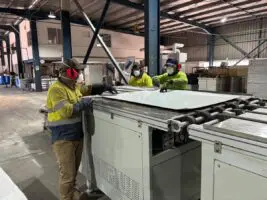It’s taken a few years, but it appears that the Australian electricity network operators have had an epiphany. The business is not about them after all, it’s all about the customer. And rooftop solar is not quite the enemy it was made out to be.
At the Energy Networks 2016 conference in Adelaide last week – a bi-annual gathering of nearly 1,000 folk from government and privately owned networks around Australia, and many of the people who seek to do business with them – “customer” was the main buzzword.

The interests of the customer, everyone agreed, was paramount. “We have to do what any organisation does, and understand what the customer wants,” said Paul Italiano, the head of transmission group Transgrid, and a former chief of WA distributor Western Power.
Merryn York, Italiano’s counterpart at the Queensland equivalent, PowerLink, agreed, as did just about every speaker: “We have got to focus on the customer,” York suggested.
If that sounds like a statement of the bleeding obvious, it was also, as many suggested, a significant change in attitude from an industry that has seen itself, quite literally, as the centre of power for decades or more. And with no need, or indeed any legal authority, to deal directly with the end user.
But the falling arc of new technology costs on one hand, the rising arc of the costs of the old business model on the other, has forced a radical change in thinking. The question might be: Is it too late?
Rooftop solar, once seen as a pest, a nuisance and an expensive indulgence of inner city latte-sippers, is now seen as an inevitability. And one that should be welcomed, because with the added benefits of storage and smart technology, it is cheaper, cleaner and can add stability and reliability to the grid.
“Solar and battery storage will be in every home in the future,” said Rob Stobbe, the head of South Australia Power Networks. And, most analysis suggests, it will be providing around half of all electricity demand sometime not so very far in the future.
Resistance, therefore, is futile, which may explain the disappearance (almost) of another favourite buzzword of utilities in the past few years – the death spiral.
As Ann Burns, from the consultancy group Accenture, suggested, the “death spiral” was a term of convenience used by those who did not want to adapt. “I haven’t heard anything about the death spiral in the last 18 months,” she said. “Utilities now say they want to be the facilitators of the energy transition.”
That means adapting to customer needs, because that is where the power now lies (there are, after all, 1.5 million power stations in the nation’s households). And what does the customer want? Cheaper electricity prices obviously. And reliability. And rooftop solar PV. And battery storage. And, who would guess: The delivery of all that is entirely possible.
“It is not a matter of inventing solutions,” Italiano said. “There are a lot of solutions.” Utilities, he says, have to stop labelling such technologies as a problem. “It is a consumer choice. Implement a solution.”
Paul Adams, the head of Jemena, which owns electricity and gas networks, said: “The system of the future, if it is to have the customer at the heart, will enable the consumer to get whatever he wants out of the deal.”
But if rooftop solar is not the enemy it appeared to be, it would be wrong to assume that networks are suddenly about to become its best friend. There is no indication that rules the solar industry finds punitive and restrictive – connection rules and regulations, low feed-in tariffs, export limitations, and new “demand tariffs” that are not as cost reflective as the network make them out to be – are about to be revised any time soon.
Even SAPN, for instance, has proposed tariff structures that it admits will slow down the uptake of rooftop solar, but may encourage more battery storage – something it is trying to accelerate through its own trials that may add the benefit of reduced network bills.
The reality is that these issues will not be addressed until either battery storage costs fall far enough to be taken up by the mass market, and/or the incumbent utilities figure out a new business model to adapt.
So, who wins in this new energy architecture? And with what models? The truth is, no one is too sure. Retailers don’t want networks muscling in, networks don’t want to be excluded from the consumer market, arguing that it makes sense if they can gain efficiencies from avoided network costs.
That leads to the tricky question about all the money spent on building big grids, the principal aim of the past decade. That in turn, has been the over-riding cause of surging electricity bills.
Can the networks they price their services competitively without taking massive write downs on what may become at least partially redundant assets? – something the networks lobby group refuses to countenance.
As Kobad Bhavnagri, from Bloomberg New Energy Finance, suggested earlier in the conference, the new technologies will usher in a new array of services. “Who provides these will be an evolving contest.” And price will be critical.
“If you irritate them so much and make them pay the same amount even though they think they are using it only one third as much (because of their solar and storage), then you will get irrational responses,” Bhavnagri warned.
Hence the big focus on the “ring fencing rules” currently being negotiated with the market regulators. It has huge implications for network providers, retailers, and a host of smaller players that want to be in the market too.
The networks are pretty confident of their future. Ron Stobbe, the head of SA Power Networks, who said at the same conference two years ago that he saw a future for networks, but not for retailers and generators, hasn’t changed his mind. “We (the networks) will be only ones around in 30 years to look after everything,” he said.
Jemena’s Adams agrees that there will be great change, and quickly too. He flagged new players, the Googles of the world, also entering the market in a big way. And, he added: “The current model of retailer and a network operator – that is not going to the model in five-10 years time.”
So, what do the non-network players in the industry say?
There were not that many at the conference, apart from AGL managing director Andrew Vesey, who is not afraid of saying that the future is uncertain, and admitting that the players in the industry simply don’t know which business model will succeed.
What is certain, Vesey told the conference, is that the “technology paradigm” based around large-scale generation and large-scale poles and wires is over. The Native Americans have a saying, he said: “When you are riding a dead horse, dismount.”
The problem, Vesey continued, was that while everyone was coming to the realisation that technology had made the fundamental business models dead and redundant, most people were spending most of their efforts trying to be the best rider of a dead horse.
And he used another quote to illustrate that point, and the situation that utilities of all types find themselves in: “Change takes a long time to come, but when it does, it happens too quickly.” And, it appears, that’s what the networks just figured out.








